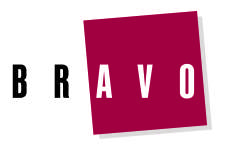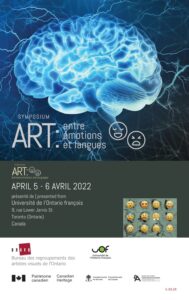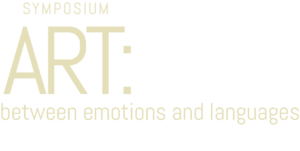
Brain, emotions, language, art and creativity
Explore how neurobiology, the study of emotions, and mother language have an impact on creativity and art appreciation.
Toronto | April 5 to 6 2022
UNIVERSITÉ DE L'ONTARIO FRANÇAIS
In hybrid format | in-person and virtual

Satellite Events
Monday April 4, from 5:30 pm to 8:00 pm at the l’Alliance Française in Toronto (24 Spadina Rd.)
Opening of the exhibit Un oeil | Cinq piliers en arts visuels de l’Ontario français and the launches of the book Confluences by BRAVO and FR magazine by the AGAVF.
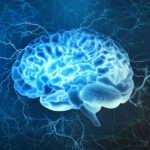
Tuesday APRIL 5 2022
(1:00 PM) Presentation
Bureau des regroupements des artistes visuels de l’Ontario
Welcoming > Mónica Márquez
Territorial Acknowledgement
Words from our main funders
Presentation of the “Symposium” > Prof. Yves M. Larocque
(1:30 PM) The hominization of the brain: from genes to culture | Epigenetics, consciousness, and culture
Prof. Jean-Pierre Changeux
CNRS et Collège de France, Paris, France
The work of art is generated by the brain’s “physical-chemical machinery”, whose development is not only born of genetics but also of its familial, social, and cultural environment, hence the “epigenetic development of the brain”. What is the role of emotions in the epigenetic development of the brain? Where lies consciousness?
(2:30 PM) Emotions, feelings, and the human condition
Prof. Gerald Cupchik
University of Toronto
Where do emotions come from? Are emotions universal? What is the difference between emotions and feelings? What are the links between emotions, mind and body? How the appeal to emotions is effective to influence behavior and trigger action?
(3:45 PM) The importance of the mother tongue in an era of English and digital hegemony
Prof. Jean Grondin
Université de Montréal
There is no doubt that our cultural situation is increasingly dominated by the dual hegemony of English and new digital technologies. If these enable new forms of communication and even creative work, they threaten many forms of communication rooted in a mother tongue other than English and risk leading to an impoverishment of our civilisation and our experience of the world. Starting from the model of contemporary philosophy and hermeneutics, this short paper will attempt to highlight some of the impasses caused by this new cultural hegemony and to justify modes of expression, thought and creation that are rooted in their mother tongue and in a temporality other than that of digital technologies.
(4:45 PM) Fostering Creativity : Insights from Neuroscience
Prof. Oshin Vartanian
University of Toronto, Canada
There is growing evidence from neuroimaging to suggest that creativity emerges from the dynamic interaction of large-scale networks in the brain − each of which supports a different mode of thinking. Can artists develop the ability to shift between these modes of thinking to boost the generation of novel ideas? (en anglais)
(6:00 PM - 7:00 PM) Opening reception at the UOF

Wednesday APRIL 6 2022
(9:15 AM) Beauty in the brain | Brain, emotions, visual arts, and newness
Prof. Jean-Pierre Changeux
CNRS et Collège de France, Paris, France
The work of art is a cerebral production engaged in a kind of social communication, distinct and complementary to language. It intervenes mainly in the sharing of emotional states and is subject to constraints, which are those of the rules of art. How can the visual artist maximize the impact of his work on the viewer?
(10:15 AM) The brain, emotions, memory and music
Prof. Hervé Platel
Université de Caen, France
Music is an art of memory, because in order to fully appreciate the listening of a work, it is necessary to keep in immediate memory the elements already perceived and to compare them with the repertoire of the music already heard in our life, so that each new music becomes meaningful and is lived and analyzed as an aesthetic experience, whether we like or not what we have just heard. The memories and all the musical moments could potentially be associated by particular emotions that would not be preserved independently of their associated contents.
(11:15) Emotions, culture and aesthetic judgment
Gerald Cupchik
University of Toronto, Canada
The depth of the aesthetic experience reflects the quality of the interaction that results from an encounter between either an artist or a beholder and a a work of art. It involves a balance between familiar themes or qualities (mimesis) and personal meanings (spirit resonance). To what extent are our judgments of quality integrated with our lives and feelings? (en anglais)
(1:30 PM) Emotions, mother tongue and second languages
Jean-Marc Dewaele
Birkbeck, University of London, U.K.
Multilinguals prefer to communicate their emotions in particular languages because of perceived emotional resonance. Why are languages acquired early in life usually felt to be more emotional and powerful? What is the impact of language choices in self-expression?
(2:30 PM) Culture, multilingualism and creativity
Prof. Enrica Piccardo
University of Toronto, Canada
The experience of linguistic and cultural diversity can have a significant impact on the creative potential of individuals who find themselves constantly mediating between different languages, cultures, identities, and worldviews. This back and forth stimulates an awareness of the complexity and fluidity of the plurilingual experience. Plurilinguals would be more capable of perceiving and crossing boundaries, thus creating in-between spaces and making them spaces of cre-action.
(3:45 PM) Body, Senses, and Creativity
Vanina Leschziner
University of Toronto, Canada
When creating a new song, a piece of art, or a culinary dish, the information and stimuli on which individuals draw on are associated to their sensory experiences of the sound of instrumental combinations, the texture of clay or oil paints, or the smell, taste, and appearance of ingredients they have either experienced in the past or have yet to experience. In short, the knowledge artists draw on for their creative endeavors is better understood as grounded in their own flesh and blood. (en anglais)
( 4:45 PM) Conclusion
(6:30 PM - 8:30 PM) AGO Bistro - Book Launch "Laurent L. Vaillancourt, à la confluence de l'art conceptuel et d'un nouvel Ontario"
Laurent L. Vaillancourt
Visual artist established in Hearst (Ontario)
For the past 40 years, Laurent L. Vaillancourt has been an agent of change on the Francophone art scene in small communities in Ontario. His work, resolutely assuming his roots, explores Francophone identity with strategies that promote mutual understanding and highlight a plural identity. His work shows that an artist can not only settle in the North but also renew himself and, more significantly, be part of the major trends in current art, producing relevant work that is in tune with the times.
by Gabrielle-Louise Noël and edited by Yves M. Larocque
BISTRO of THE ART GALLERY OF ONTARIO (AGO) on 317 Dundas St. W
BAILLEURS de FONDS | FUNDERS
![]()


PARTENAIRES FINANCIERS
"RHODIUM"

"PLATINE"
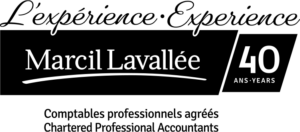

"OR"
"ARGENT"
"BRONZE"
PARTENAIRES DE PRÉSENTATION | PRESENTATION PARTNERS

![]()
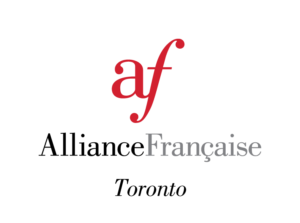
PARTENAIRES CULTURELS | CULTURAL PARTNERS
 |
 |
||
 |
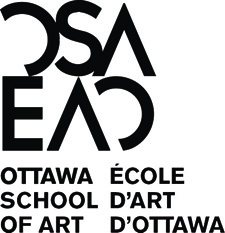 |
 |
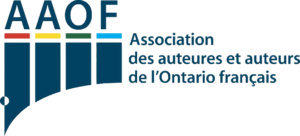 |
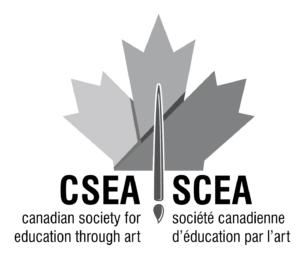 |
 |
||
 |
|||
![30_5-BRAVO_Centre_Pant_1955 [Converted]](https://art-entre-emotions-et-langues.com/wp-content/uploads/2021/04/30_5-BRAVO_Centre_Pant_1955-Converted.png)
© Walk the Arts | BRAVO 2022
BRAVO | SA MISSION, SON HISTOIRE
À l’image de la communauté francophone de l’Ontario, BRAVO réunit les artistes en arts visuels, médiatiques et de métiers d’arts et les appuie dans leurs milieux respectifs, pour leur permettre d’atteindre leurs objectifs professionnels.
![]()
![]()
![]()
